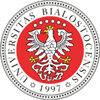Proszę używać tego identyfikatora do cytowań lub wstaw link do tej pozycji:
http://hdl.handle.net/11320/18989| Tytuł: | Translation and Anchoring Bias: A Study of Equivalence in English-Polish Student Translation Tasks |
| Inne tytuły: | Tłumaczenie a efekt zakotwiczenia. Badanie ekwiwalencji w angielsko-polskich tłumaczeniach dokonanych przez studentów filologii angielskiej |
| Autorzy: | Litwin, Maciej |
| Słowa kluczowe: | translation equivalence metrics anchoring bias re-translation corpora pomiar ekwiwalencji w tłumaczeniu zakotwiczenie korpusy tłumaczeń |
| Data wydania: | 2025 |
| Data dodania: | 9-paź-2025 |
| Wydawca: | Wydawnictwo Uniwersytetu w Białymstoku |
| Źródło: | Linguodidactica, T. 29, 2025, s. 129-142 |
| Abstrakt: | The study looked at 94 re-translations of the same source text in order to investigate anchoring effects in translation decisions. The analysis focused on two two-level explanatory variables corresponding to binomial grammatico-syntactic choices and tested anchoring effects against the proposed equivalence measure (length production metric related to object range estimate in context). The anchoring effect was observed in 0.7 of re-translations for both explanatory variables. When tested for statistical significance of the equivalence measure, the anchoring group contained versions whose length-to-words ratio was higher when the original anchor was an unidiomatic verb phrase, and versions whose length-to-words ratio was lower when the original anchor was idiomatic syntax corresponding to human-scale conceptualization of a tourist visit scenario (although the results were up to two per cent short of the statistical significance threshold for both tests). W badaniu przeanalizowano 94 tłumaczenia tego samego tekstu i dokonano obserwacji efektu zakotwiczenia w decyzjach tłumaczeniowych. Analiza skupiła się na dwuwartościowych decyzjach tłumaczeniowych, odpowiadających opcjom gramatyczno-syntaktycznym, które przetestowano w oparciu o zaproponowany metakognitywny miernik ekwiwalencji (pomiar długości względem szacunkowej liczby obiektów w wypowiedzeniu). Efekt zakotwiczenia zaobserwowano w 70 procentach tłumaczeń zarówno dla pierwszej jak i drugiej zmiennej objaśniającej. W badaniu istotności statystycznej średni iloraz długości i liczby słów w zdaniach był większy dla grupy z efektem zakotwiczenia, kiedy zakotwiczenie opierało się na nieidiomatycznym orzeczeniu oraz mniejszy, gdy zakotwiczenie opierało się na naturalnej konceptualizacji scenariusza zwiedzania (rezultaty obu testów blisko progu istotności statystycznej). |
| Afiliacja: | University of Wrocław |
| E-mail: | maciej.litwin@uwr.edu.pl |
| URI: | http://hdl.handle.net/11320/18989 |
| DOI: | 10.15290/lingdid.2025.29.09 |
| e-ISSN: | 2957-0204 |
| metadata.dc.identifier.orcid: | 0000-0001-5881-5550 |
| Typ Dokumentu: | Article |
| metadata.dc.rights.uri: | https://creativecommons.org/licenses/by-sa/4.0/deed.pl |
| Właściciel praw: | CC BY-SA 4.0 Uznanie autorstwa – Na tych samych warunkach |
| Występuje w kolekcji(ach): | Linguodidactica, 2025, tom XXIX |
Pliki w tej pozycji:
| Plik | Opis | Rozmiar | Format | |
|---|---|---|---|---|
| Linguodidactica_29_2025_M_Litwin_Translation_and_Anchoring_Bias.pdf | 249,24 kB | Adobe PDF | Otwórz |
Pozycja ta dostępna jest na podstawie licencji Licencja Creative Commons CCL


